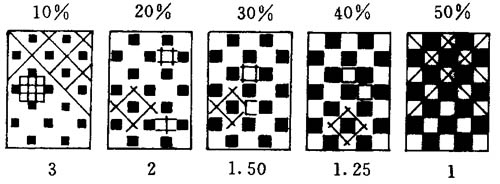Figure 1-5 dot pitch

The dot shape is divided into common dot shapes and special dot shapes. Commonly used dot shapes (square dots, circular dots, chain dots) Screens are commonly used dot shapes in current production. Special points (child points, triple points, ripple points, concentric circles, etc.) are specially designed dot shapes for special artistic effects to improve the tone of the image (Figure 1-6). Nowadays, with the development of computer technology, the screening technology has also been continuously updated. For example, art screening, three-dimensional screening, imitation material screening, and the like are continuously applied in offset printing.
Figure 1-6 Network type

(2) The number of dot lines is also called the number of screen lines or screen frequency. It refers to the number of parallel lines contained in a unit length, that is, the number of unidirectional transparent parallel lines per inch.
Because 1 inch = 2.54 cm, the imperial and metric system can be converted to each other (Table 1-3).
The finer the network cable is, the more network points are accommodated within a unit area, and the higher the line number of the outlet, the faster the number of outlets accommodated in a unit area increases. The increase in the number of outlets has greatly enriched the level of print expression and enhanced the effect of tune-up copying.
Conversely, if the number of outlets is reduced, the level of expression on the screen will be reduced, and the effect of copying will also be reduced. However, the choice of line count depends on the type of print, the type of paper, and the surface condition.
Table 1-3 Number of screen lines
Table 1-4 Net weights of different types of prints Print categories Loosing paper
(3) Outlet angle The outlet angle generally refers to the angle between the arrangement line (mesh line) and the horizontal line (reference line).
Offset printing is the use of printing plates with different dots to overprint the original color. For four-color overprinted prints, if the four printing plates have the same dot angle and the corresponding dots on the printing plates accurately overlap during printing, the best results will be obtained, but this is not possible. Usually there is a certain angular difference between the dot angles of the four printing plates (Figure 1-7). Theoretical calculations and human visual experience have all found that when the angle difference of the halftone dot of the printing plate is 30°, the visual effect of the printed matter is the best, and the moiré formed by interference is hardly seen by human eyes, and the image is uniform and harmonious. When the dot angle difference is 22.5°, the visual effect of the print is not as good as the former, but it also looks soft and pleasing. When the dot angle difference is 15°, the visual effect of the printed matter is the worst, and it looks extremely uncomfortable. Therefore, in practical use, the dot angle difference of 30° or 22.5° should be used as much as possible, and the dot angle difference of 15° is avoided. However, within the range of 90°, only three colors can be arranged at an angle difference of 30°, and one color can only be used with an angle difference of 15°. Because yellow is the lightest, it is closest to the brightness of white paper. The visual sensations caused by cyan, magenta, and black inks are more intense than yellow, so cyan, magenta, and black are usually arranged at a 30° angle difference, and the yellow plate is arranged at a 15° angle difference.
Figure 1-7 Dot Perspective

In order to avoid the appearance of moiré, people have carefully arranged the dots of multicolor printing through theoretical and practical exploration.
If four printing plates adopt four different angles of 90°, 75°, 45°, and 15°, respectively, the dot angles between the second, third, and fourth plates are all 30°, and only the first and second plates are used. The difference in the dot angle between the dots is 15°. In terms of visual effects, the dots arranged at 45° have a dynamic beauty and look extremely comfortable. The dots that line up at 90° appear to be sluggish. Dots arranged at 15° or 75° have an effect that lies between the two. In addition, it must be considered in the angular arrangement that the strong color version (main color version) mostly adopts a 45° screen angle.
It is in the offset printing process that dots of different shapes are used, that is, the percentage of dots used, the number of dots of the dots, and the angle of the dots make the print reproduce the original.
Source: Ke Yin Network
Silicone Baking Molds,Silicone Pudding Mold,Silicone Pudding Pan,Silicone Mold For Cupcake
Yangjiang Kasonn Industrial & Trading Co., Ltd. , http://www.kasonn.com